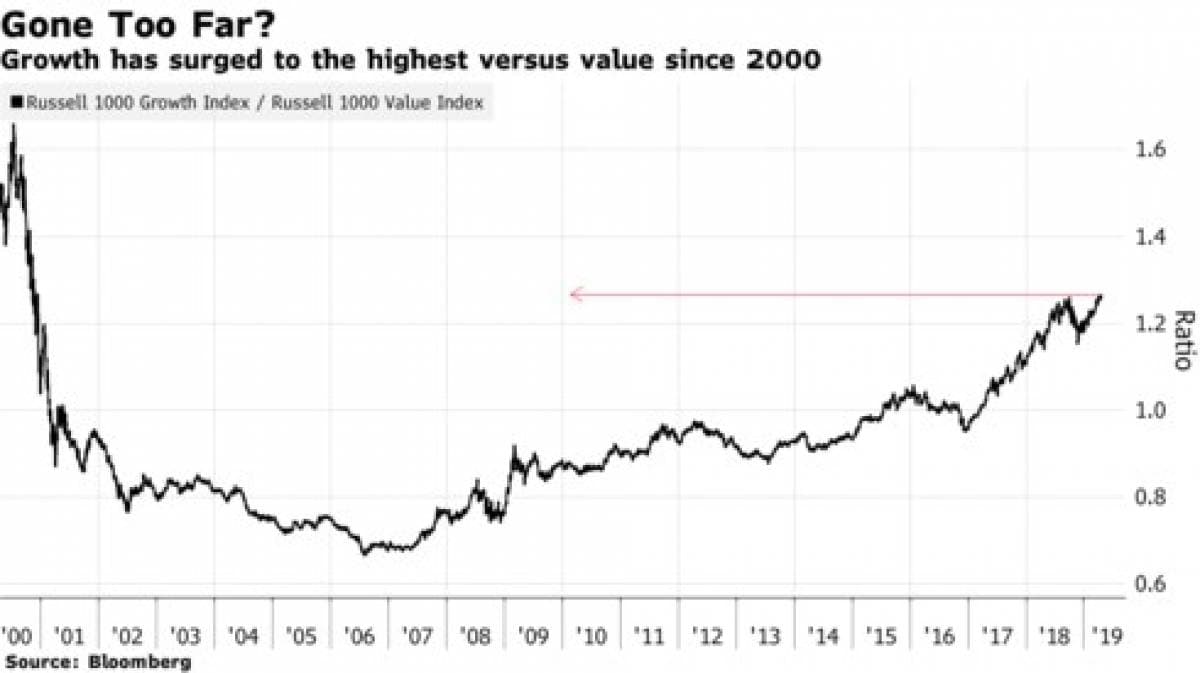Friday April 26, 2019
1. Permian gas prices depressed
(Click to enlarge)
- Natural gas at the Waha Hub in the Permian basin plunged deep into negative territory earlier this year and will remain depressed until new pipelines come online.
- But prices could rise later this year if Mexico begins to import more gas. “Although with significant unutilized export capacity to Mexico, the risk of increased Mexico demand growth providing an outlet for constrained Permian natural gas keeps 3Q19 Waha basis relatively supported,” Bank of America Merrill Lynch wrote in a report.
- A brewing problem for Permian drillers comes in the form of rising gas-to-oil ratios, a sign that the frenzied drilling is showing signs of wear and tear on the basin. That could lead to higher rates of well shut-ins, which would ultimately provide a boost to Permian natural gas prices.
- “[T]he potential for high gas to oil ratio (GOR) wells to shut-in limits Waha weakness, and could provide a brief price spike if too many wells shut in production,” Bank of America said. However, “[a]ny price spike would likely be brief as we expect shut-ins would quickly return to service.”
2. LNG prices crashed as supplies continue to rise
(Click to enlarge)
- The wave of new LNG export terminals coming online this year have led to a plunge in prices.
- “Asian LNG demand digested nearly all of the LNG supply growth over the past couple of years, but in recent months…
Friday April 26, 2019
1. Permian gas prices depressed

(Click to enlarge)
- Natural gas at the Waha Hub in the Permian basin plunged deep into negative territory earlier this year and will remain depressed until new pipelines come online.
- But prices could rise later this year if Mexico begins to import more gas. “Although with significant unutilized export capacity to Mexico, the risk of increased Mexico demand growth providing an outlet for constrained Permian natural gas keeps 3Q19 Waha basis relatively supported,” Bank of America Merrill Lynch wrote in a report.
- A brewing problem for Permian drillers comes in the form of rising gas-to-oil ratios, a sign that the frenzied drilling is showing signs of wear and tear on the basin. That could lead to higher rates of well shut-ins, which would ultimately provide a boost to Permian natural gas prices.
- “[T]he potential for high gas to oil ratio (GOR) wells to shut-in limits Waha weakness, and could provide a brief price spike if too many wells shut in production,” Bank of America said. However, “[a]ny price spike would likely be brief as we expect shut-ins would quickly return to service.”
2. LNG prices crashed as supplies continue to rise

(Click to enlarge)
- The wave of new LNG export terminals coming online this year have led to a plunge in prices.
- “Asian LNG demand digested nearly all of the LNG supply growth over the past couple of years, but in recent months has struggled to keep up with the latest wave of supply growth,” Bank of America Merrill Lynch wrote in a report.
- Prices have dropped so low that after factoring in liquefaction and transportation costs, the margin for shipping U.S. LNG to Asia has fallen close to zero.
- “We are concerned that global LNG demand will be unable to keep pace with continued LNG supply growth over the next two years,” Bank of America wrote. “The US is expected to grow LNG export capacity by nearly 6 bcf/d in 2019-20 and will represent 17% global LNG supply by the end of 2020.”
- Meanwhile, some LNG cargoes under longer-term deals linked to Brent are now trading above $10/MMBtu while spot cargoes are around $5/MMBtu, the widest gap in 8 years. That is leading to some buyers trying to delay immediate deliveries, according to Reuters.
3. Texas oil lightening up the oil mix

(Click to enlarge)
- The surge of light oil coming out of the Permian is a challenge for the oil market as the supply of medium and heavy blends become increasingly tight due to sanctions on Venezuela and Iran, as well as declines in Mexico and pipeline bottlenecks in Canada.
- At the same time, the U.S. shale industry is beginning to focus more on the Delaware basin as opposed to the Midland basin in the Permian. The Delaware tends to produce an ultralight form of oil with an API gravity averaging 45 degrees in 2018. Midland crude averages closer to 40 degrees (a bit heavier).
- The surge in light and ultralight oil has led to the introduction of a new benchmark, the West Texas Light (WTL) benchmark. WTL is intended to differentiate the light oils from West Texas Intermediate (WTI).
- The WTL has an API gravity of between 44 and 50 degrees.
- “Pipeline segregation is also required for lighter WTL type crudes, resulting in batched shipments, which are likely to increase in frequency as superlight Permian production continues to rise,” Bank of America wrote in a report. WTL is trading at a discount of a few dollars per barrel below Midland WTI.
4. Has the stock market climbed too high?

(Click to enlarge)
- The S&P 500 broke new records this week, but there are some signs that the market could be near a major shift.
- The value of “growth” stocks are at their highest premium to “value” stocks since the dot-com bubble in the late 1990s and early 2000s.
- “It is pretty clear that the market is fairly bifurcated at this point with growth and defensive companies designated as winners and everything else a loser,” Morgan Stanley strategists wrote in a Monday note. “That’s a classic late-cycle playbook but it does appear to have gotten a bit extreme at this point.”
- Analysts see traders shifting into safer companies, but in so doing, have driven up share prices to potentially unsustainable levels, Bloomberg reports.
- “With a U.S. recession widely expected at some point over the next 12-18 months and very little earnings growth forecast in Europe, many wish to be positioned in ‘Quality,’” Bernstein strategists wrote in a note last week. “However the valuations seem prohibitive.”
5. More signs of Bitcoin rebound

(Click to enlarge)
- Bitcoin has staged a small rally in the last few weeks. One technical piece of evidence working in Bitcoin’s favor is the re-emergence of a so-called “golden cross” for the first time since late 2015.
- “The technical picture for [bitcoin] is looking increasingly bullish on the daily charts with the fabled bullish ‘golden cross’ slowly coming into play,” said Lukman Otunuga, research analyst in a Tuesday note.
- The golden cross occurs when the 50-day moving average crosses over the longer-term 200-day moving average. In other words, short-term surpasses the longer-term trend line.
- Earlier this week, Bitcoin rose above $5,500, a five-month high.
- According to MarketWatch and DailyFX, roughly 80 percent of retail traders have staked out net-long positions on Bitcoin.
6. Energy storage set to surge

(Click to enlarge)
- Energy storage costs are falling and more markets are opening up. “The first markets to foster investment in a big way share similar characteristics: an overarching decarbonisation policy, liberalised, unbundled markets and an independent regulator,” Wood Mackenzie said in a note, including the U.S., Germany and the UK.
- “New markets are now proliferating, including Australia where Tesla has installed the biggest lithium-ion battery in the world, at 129 MWh. In the last two years, South Korea – home to the big battery manufacturers Samsung, LG Chem and SK Innovation – has emerged as a boom market,” WoodMac said.
- Last year, energy storage investment reached a record 7 GW, double from a year earlier, although a tiny fraction of the 6,776 GW of global power generation capacity.
- While growing from a small base, energy storage is expected to expand quickly, growing by 29 percent per year through 2024, WoodMac estimates.
7. Gold holding despite dollar surge

(Click to enlarge)
- Gold held at $1,275 per troy ounce this week, despite the rise in the U.S. dollar.
- “The trade-weighted dollar index climbed yesterday to its highest level in almost two years, which our FX colleagues attribute primarily to a weak euro,” Commerzbank said in a note.
- Nevertheless, gold is hovering near four-month lows due to the greenback’s renewed strength, which has come even as the U.S. Fed has taken a more dovish stance on interest rates.
- “A good portion of gold’s weakness has come from recent highs in the dollar against major currencies, and lack of safe-heaven buying amidst equity markets continuing higher and slightly better global economic outlook,” David Meger, director of metals trading at High Ridge Futures, told Reuters.
























